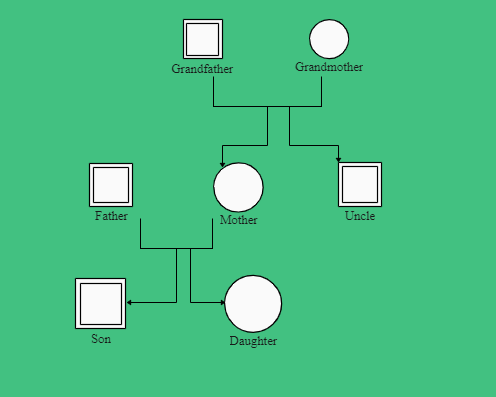Introduction
The provision of suitable medical services to the population depends on the understanding of their actual needs at different times. For this purpose, conducting a family assessment for the development of an appropriate clinical action plan is critical for obtaining sufficient information in this respect. Therefore, the selected individuals were asked to provide demographic and environmental data and tell about their history, structure, functions, stress coping, and composition in order to design further care programs.
Demographic Data
The socioeconomic aspect of the matter was addressed by asking about age, gender, ethnicity, employment status, and ownership of material things. Thus, the mother replied that she was 36, and her husband was 38 years old, whereas the children, a boy and a girl, were 8 and 10 years old, respectively. They were Caucasian living in a medium-size house that they purchased a few years ago. The family has two cars, making it convenient to travel with one of the parents when kids need it. Currently, both adults are employed in a local company producing and processing textiles, and their income is sufficient for covering their essential needs.
Developmental Stage and History of Family
At the time of the interview, the examined family was in the developmental stage of parenting adolescents. They were successfully cooperating with one another in facilitating the psychological formation of the children and did not experience any difficulties in the process (“Family life cycle,” 2020). The couple got married in 2015, and by that moment, their lives were quite stable in terms of education, income, and employment. Over the history of these people, the only problems they faced were financial limitations after having children when the mother had to stay at home for over four years.
Environmental Data
In general, the environment in the family seems positive since all its members respect one another’s needs and are quite supportive. However, there is a challenge of varying values of the people as the parents are focused on following rituals, such as dinners every night and visiting other relatives on holidays. Meanwhile, their children from a young age seem more independent and occasionally attempt to avoid similar gatherings and spend more time on their own. This tendency can be explained through the lens of the lack of awareness of parents concerning the needs of the new generation (Latifah et al., 2019). It presents the only threat to the well-being of the affected persons.
Family Structure and Functions
The family structure is nuclear, which is a traditional union of a couple and their offspring. It ensures the required degree of stability for the children, thereby increasing their chances for well-being in the future. The people were reported to be oriented on providing the young members with all opportunities in terms of education and other critical services for addressing this objective. As for their functions, they include physical care of one another, meeting the socialization needs of the children, showing affection for promoting mental health, and fulfilling economic obligations (see Appendix B). In this way, all individuals receive the required support in all of the mentioned areas and, therefore, can rely on their relatives when facing challenges in life.
Family Stress and Coping
In the family, the coping mechanism for dealing with stress is related to the attempts to develop the skills necessary for overcoming obstacles in children while emphasizing their independence and supporting their decisions. The parents pay particular attention to the struggles of their offspring in school, especially in the area of communicating with peers. This method allows them effectively monitor the cases and guide their daughter and son in addressing the issues (Compas et al., 2019). The approach to stress in adults does not seem to be well-developed as they confirmed the lack of critical challenges in this respect and, consequently, the absence of practice in managing alarming situations. Hence, this factor can serve as a possible threat to their well-being if they experience unexpected difficulties.
Family Composition
The family under consideration mainly consists of four people, more specifically, a mother, a father, a daughter, and a son. According to their responses, they rarely communicate with other relatives, mostly on holidays, and there are not many of them. They are a single uncle, the mother’s brother, and their elderly parents, who live in a nursing home (see Appendix A). Since they do not communicate often, these people do not influence the overall family environment, functions, or coping mechanisms for stress described above. Nevertheless, they play an important role in the financial sphere of life of the family because the parents tend to provide any possible assistance to them when needed.
Conclusion
In conclusion, the conducted assessment revealed the possibility of two threats with regard to the family’s wellbeing. They are chances of conflicts on the basis of varying values and the absence of support from other relatives. From this point of view, the potential challenges can be the lack of assistance for the parents in the case of crises and the issues with agreeing on their combined efforts with children. Thus, these aspects should be involved when designing further interventions for these people.
References
Compas, B. E., Murphy, L. K., Yarboi, J., Gruhn, M. A., & Watson, K. H. (2019). Stress and coping in families. In B. H. Fiese, M. Celano, K. Deater-Deckard, E. N. Jouriles, & M. A. Whisman (Eds.), APA handbook of contemporary family psychology: Foundations, methods, and contemporary issues across the lifespan (pp. 37–55). American Psychological Association. Web.
Family life cycle. (2020). The University of Michigan Health. Web.
Latifah, L., Wahyu, W., & Metroyadi, M. (2019). The influence of education, employment, and care for the independence of children. Journal of K6 Education and Management, 2(1), 8-14. Web.
Appendix A

Appendix B

